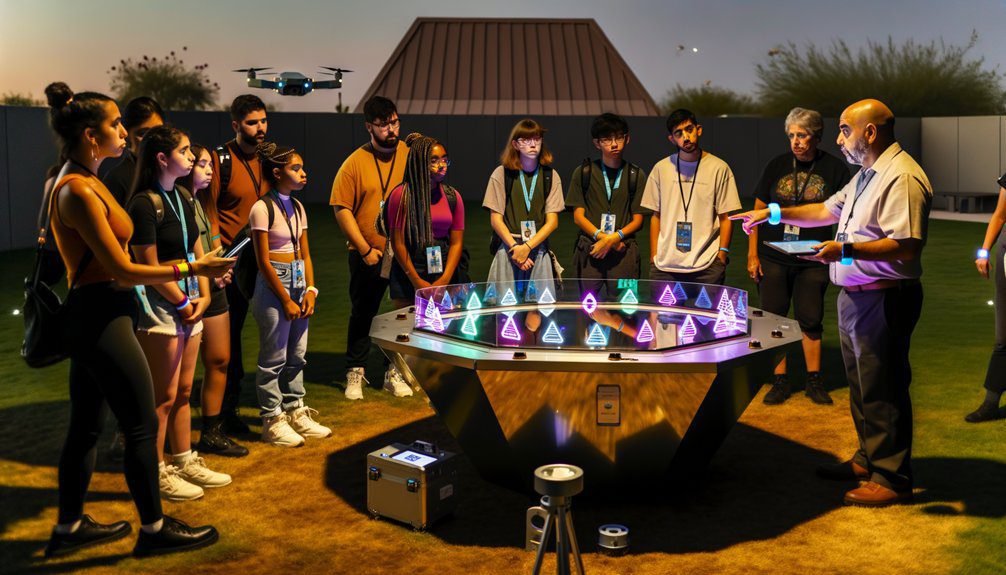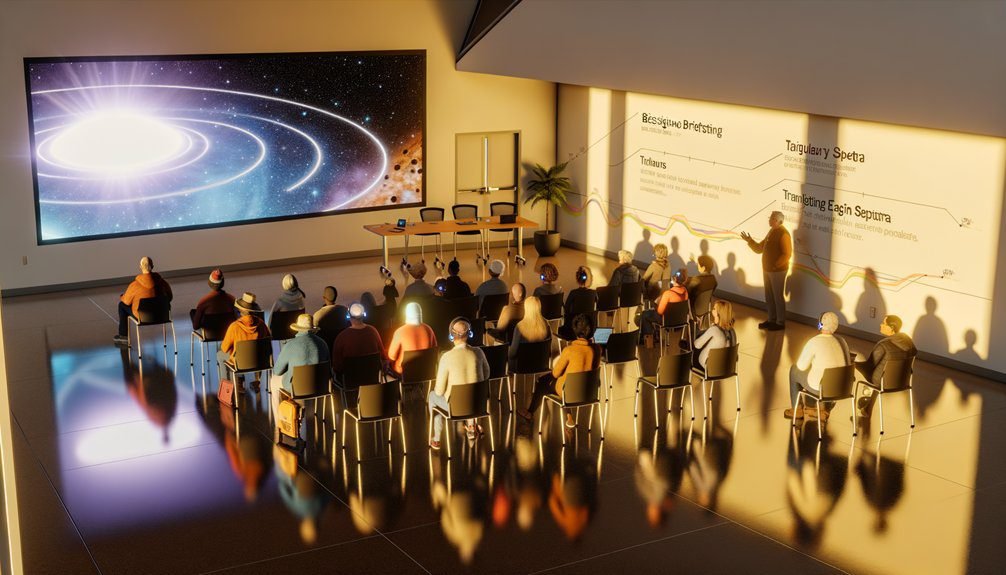You’ll get clear, cautious updates when potential signals appear, with verification steps and uncertainty explained. You can join citizen science platforms to classify data and help flag anomalies, or partner with local schools for hands-on projects. Ethical safeguards protect privacy and cultural perspectives, while amateur collaborations extend telescope coverage. Media briefings aim for accurate, non-sensational reports and spokespeople are trained. Open-data policies and community drills build trust — continue for practical steps and resources.
Key Takeaways
- Citizens can join verified platforms to classify telescope data and flag anomalies using trained workflows and real-time streams.
- Scientists will release timestamped raw and processed data with metadata for independent analysis and cross-validation.
- Media communications will emphasize uncertainty, verification steps, and regular updates to prevent misinformation.
- Educational programs will provide curriculum-aligned lessons and teacher training for classroom engagement with discoveries.
- Ethical frameworks and multilingual briefings will ensure consent, privacy protection, cultural input, and mental-health resources.
How SETI Communicates Preliminary Signals to the Public

When a candidate signal appears, SETI teams follow a cautious, step-by-step process before telling the public: they verify the data, rule out terrestrial interference, and seek independent confirmation from other observatories so you don’t get false alarms. You’ll learn that clear signal verification methods are essential: timestamping, cross-checking instrument logs, repeating observations, and running automated filters reduce false positives. When initial checks are promising, teams craft measured messages explaining uncertainty, context, and next steps so you won’t misinterpret preliminary findings. Public engagement strategies balance transparency with responsibility — timely updates, accessible summaries, and expert Q&As help you follow progress without sensationalism. You’re given sources and criteria used in analyses, so you can judge credibility. If independent observatories confirm or refute the signal, announcements are updated promptly. This approach keeps you informed, avoids premature claims, and builds trust by showing how rigorous verification and thoughtful engagement guide what’s shared and when.
Citizen Science Platforms for Signal Analysis
You can contribute directly by using citizen science platforms that train volunteers to spot and classify unusual signals. These projects pair volunteer-trained signal classifiers with open-access data streams so you can examine real telescope outputs and flag anomalies. By participating you help scale analysis, improve machine-learning models, and increase transparency in how candidate signals are vetted.
Volunteer-Trained Signal Classifiers
Although machine learning excels at crunching huge datasets, volunteer-trained signal classifiers harness human intuition to catch subtle patterns and edge cases that algorithms often miss. You’ll learn hands-on signal detection techniques while contributing labeled examples that improve automated filters. Training volunteers builds community engagement and creates a durable review layer for ambiguous events, reducing false positives and prioritizing candidates for expert follow-up. You’ll get clear workflows, feedback loops, and performance metrics so your classifications matter.
| Role | Task | Impact |
|---|---|---|
| Volunteer | Label signals | Improves training data |
| Trainer | Curate tutorials | Raises accuracy |
| Platform | Aggregate votes | Ranks candidates |
| Scientist | Validate hits | Confirms discoveries |
This model blends human judgment and automation for robust, transparent results.
Open-Access Data Streams
Building on volunteer-trained classifiers, open-access data streams give you the raw material needed to spot and label interesting signals in real time. You’ll connect to open source platforms that aggregate telescope feeds, telemetry, and spectrum slices so you can apply pattern recognition tools immediately. Interfaces present manageable chunks of data with clear provenance, and real time updates alert you to anomalies worth deeper review. You won’t need proprietary software or special clearance; contributions are versioned and auditable, so your labels help improve models and trigger expert follow-up. Clear guidelines and automated quality checks reduce false positives, while community moderation preserves scientific integrity. By participating, you accelerate discovery and learn rigorous analysis methods alongside professionals.
Educational Outreach and School Partnerships

You can bring extraterrestrial discovery into classrooms by offering curriculum-aligned lesson plans that meet standards and spark curiosity. We’ll support teachers with targeted professional development so they can confidently guide student investigations. Then students will do hands-on projects—data analysis, building simple instruments, or simulated signal searches—that make the science tangible.
Curriculum-Aligned Lesson Plans
When schools partner with researchers to integrate extraterrestrial discoveries into classroom lessons, you’ll get materials that match learning standards and strengthen scientific literacy across grade levels. You’ll find curriculum integration that ties concepts—astronomy, physics, data analysis—directly to mandated benchmarks, so administrators and teachers can justify classroom time. Lesson customization lets you adapt complexity for elementary through high school, providing clear objectives, assessment ideas, and hands-on activities that reinforce inquiry skills. Students engage with real data, build models, and learn scientific reasoning while meeting state or national standards. These lesson plans include safety notes, resource lists, and alignment guides so you can implement them efficiently. The result: accessible, standards-aligned content that makes extraterrestrial discoveries teachable and relevant.
Teacher Professional Development
Because effective classroom integration depends on teacher readiness, professional development programs should give educators practical skills, content knowledge, and ongoing support for bringing extraterrestrial discoveries into their schools. You’ll benefit from teacher workshops that model inquiry-based methods, demonstrate safe handling of data, and unpack the science and ethical questions behind new findings. Pair in-person sessions with curated online resources so you can revisit materials, adapt lessons to standards, and access subject-matter experts asynchronously. Provide short follow-ups, peer coaching, and evaluation tools so you’re confident measuring student understanding without needing to invent everything. Focus on transferable pedagogical strategies rather than one-off activities, and guarantee equity by offering stipends, substitutes, and multilingual materials so every teacher can participate and every classroom can responsibly engage with these discoveries.
Student Hands-On Projects
Building teachers’ skills lays the groundwork for student-centered, hands-on projects that bring extraterrestrial discoveries into classrooms and community programs. You’ll design student experiments that let learners test hypotheses, analyze simple spectral data, and model planetary processes with readily available materials. Pairing classrooms with researchers guarantees experimental relevance and access to real datasets, while clear protocols keep activities manageable. You’ll organize project showcases where students present findings to peers, parents, and scientists, reinforcing communication skills and scientific literacy. Assessment focuses on process, reasoning, and collaborative problem-solving rather than just “right answers.” Support materials, mentorship, and virtual guest talks help you adapt projects across age groups and resource levels. This approach amplifies public engagement and builds the next generation of informed contributors.
Ethical Guidelines for Public Participation

If you’re going to involve the public in extraterrestrial discoveries, you need clear ethical guardrails that protect people, preserve scientific integrity, and respect cultural perspectives. You’ll rely on robust ethical frameworks that define roles, responsibilities, and limits for volunteers and outreach. Secure public consent through transparent briefings, understandable risk statements, and ongoing opt-out options. Protect privacy, prevent exploitation, and guarantee data stewardship meets scientific standards. Address misinformation by committing to timely, verified communication. Include cultural advisors to honor diverse worldviews and avoid imposing narratives. Train participants in evidence handling and reporting norms so contributions aid reproducibility. Establish review boards with public representatives to oversee engagement and resolve disputes. Monitor outcomes and iterate guidelines based on feedback and independent audits.
| Guideline | Action |
|---|---|
| Consent | Transparent briefings |
| Privacy | Anonymize data |
| Integrity | Verification steps |
| Culture | Advisory input |
| Oversight | Review boards |
Collaborations Between Amateur Astronomers and SETI Teams
When amateur astronomers team up with SETI researchers, you get a powerful blend of local expertise, widespread observing coverage, and fresh eyes on unusual signals that professional arrays might miss; to make that collaboration effective, roles, data standards, and communication channels must be clearly defined so contributions are scientifically useful and ethically managed. You can contribute through coordinated campaigns that use crowdsourced observations to validate transient events, reduce false positives, and extend time coverage across longitudes. Clear protocols for data formatting, time stamping, calibration, and metadata make your telescope sharing productive and interoperable with institutional archives. Training modules and credentialing help you follow best practices, while secure platforms let you upload raw and processed data for peer review. Agreements should address data ownership, credit, and privacy, so your work is acknowledged and responsibly used. With transparent governance and technical standards, your participation becomes a reliable, respected component of SETI research rather than an informal sidebar.
Media Strategies for Responsible Reporting

Because news about potential extraterrestrial discoveries can cause confusion or excitement very quickly, journalists and institutions need clear, responsible media strategies that prioritize accuracy and context. You should insist on verification before publication, distinguishing speculation from confirmed findings, and using clear labels for preliminary results. Apply media ethics consistently: avoid sensational headlines, respect sources, and prevent undue alarm by framing probabilities and uncertainties plainly.
When you report, balance public interest with caution, giving audiences the tools to evaluate claims and the scientific process. Use expert voices to explain methods without oversimplifying, and correct errors visibly and promptly. Develop preplanned communication protocols with research teams so you won’t rush incomplete data to the public. Train spokespeople in clear, measured language and commit to follow-up coverage as evidence evolves.
Transparency and Data Sharing Policies
Although transparency won’t eliminate uncertainty, clear data-sharing policies will build trust and improve verification when possible extraterrestrial discoveries are reported. You need to know what data will be released, when, and under what constraints so you can assess claims without relying solely on headlines. Effective data transparency means standardized formats, metadata that explains methods and limitations, and repositories that are accessible to qualified researchers and the public where appropriate.
Your confidence grows when institutions publish raw and processed data alongside provenance records and review timelines. Sharing policies should balance openness with security, protecting sensitive infrastructure while avoiding unnecessary secrecy that fuels speculation. You should expect clear criteria for embargoes, independent replication, and third-party audits. Policymakers and agencies must commit to timely updates and explain uncertainties in plain language. When you can see the data and understand the rules for access, you’re better equipped to evaluate discoveries, participate constructively, and hold institutions accountable without spreading misinformation.
Preparing Communities for Confirmed Discoveries

If a confirmed extraterrestrial discovery is announced, communities should be ready with clear plans that address information flow, public safety, and social support; you’ll need coordinated protocols that translate scientific findings into practical guidance, outline roles for local agencies, and provide resources for mental-health and misinformation management. You should focus on community engagement and discovery readiness so people trust the process and know what to do. Key steps include transparent communication, staged advisories, and support networks that scale with impact.
- Establish local liaison teams linking scientists, public health, and emergency services.
- Create clear, multilingual communication templates for different discovery phases.
- Train mental-health responders for anxiety, grief, and rumor-related stress.
- Deploy misinformation monitoring and rapid correction protocols.
- Run community drills and public forums to test procedures and gather feedback.
You’ll lead with authority, offer accessible explanations, and guarantee plans respect rights while keeping safety central to every decision.
Frequently Asked Questions
Will Governments Seize Control of Extraterrestrial Data Internationally?
Governments might try, but they won’t uniformly seize control of extraterrestrial data internationally. You’ll see tensions between national security instincts and calls for government transparency, and international treaties or new agreements will shape who accesses and shares findings. You’ll likely witness a mix: some states centralizing data, others pushing open science and multilateral oversight. Ultimately, outcomes will depend on diplomacy, treaty language, and public pressure for accountable disclosure.
Could Private Companies Restrict Access to Discovery Technologies?
Yes — you could see private companies restrict access to discovery technologies through technology ownership and corporate secrecy. They’ll control patents, proprietary platforms, and data rights, limiting who can use or verify tools. You’ll need regulatory pressure, open-science incentives, and public-private agreements to push transparency. Expect legal battles and lobbying; without clear policies, corporate control could slow independent verification and broader scientific participation despite public interest.
How Will Indigenous Knowledge Be Protected and Respected?
You’ll protect and respect indigenous knowledge by centering cultural preservation and legal safeguards, ensuring communities control access to their traditional knowledge through consent, benefit-sharing, and data sovereignty. You’ll fund community-led documentation, use culturally appropriate protocols, and involve elders in decision-making. You’ll enforce intellectual property and human rights standards, provide capacity-building, and create transparent partnerships so research honours values, keeps sacred information private, and returns tangible benefits to the communities.
Will Personal Safety Protocols Be Implemented for Contact Responders?
Yes — you’ll have personal safety protocols. You’ll undergo thorough risk assessment and receive emergency training tailored to contact scenarios, PPE use, decontamination, and psychological support. Protocols will specify roles, quarantine procedures, communication chains, and medical monitoring. You’ll be briefed on legal rights and cultural sensitivity. Regular drills and after-action reviews will refine procedures so you’re prepared, protected, and confident when responding to potential contact incidents.
Could Discoveries Impact Immigration or Asylum Policies?
Yes — discoveries could reshape immigration and asylum laws. Picture governments drawing new maps overnight: you’ll see alien refugee policies and interstellar asylum frameworks drafted to address beings without national ties. You’ll need clear criteria, health and security protocols, and rights protections aligned with human rights. Policymakers will balance humanitarian obligations, public safety, and scientific cooperation, so your legal systems will likely evolve to manage unprecedented movement and claims.